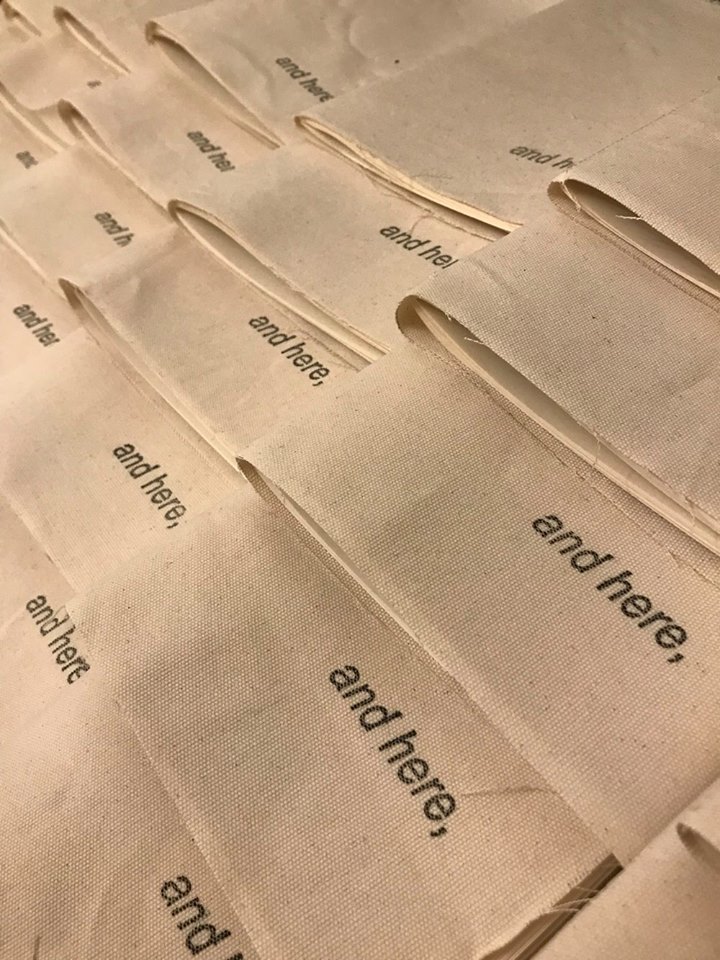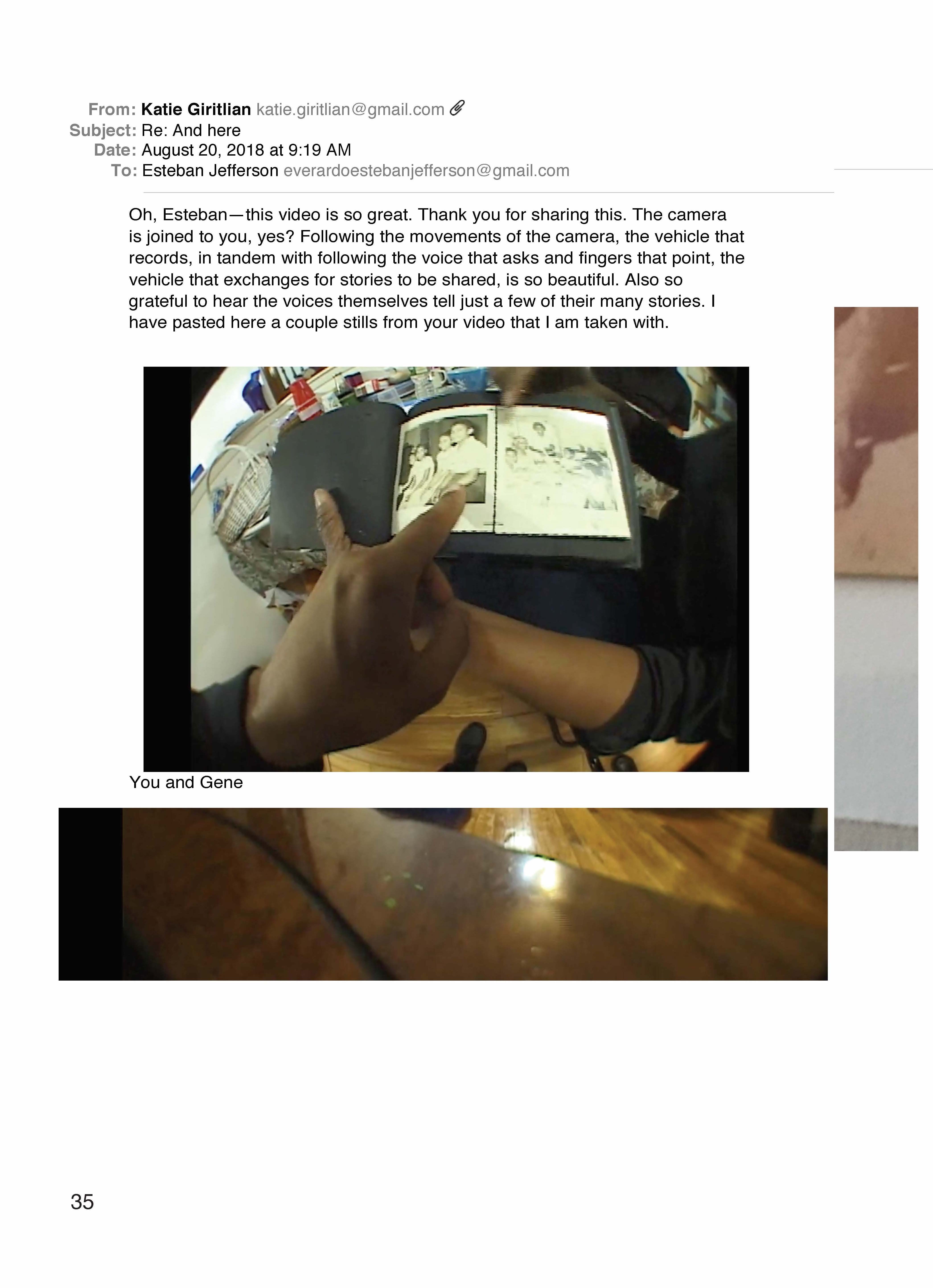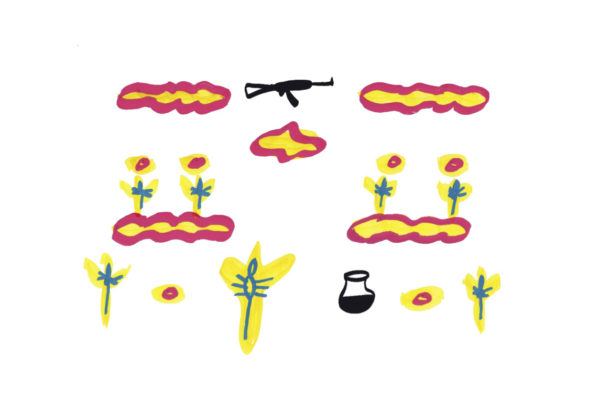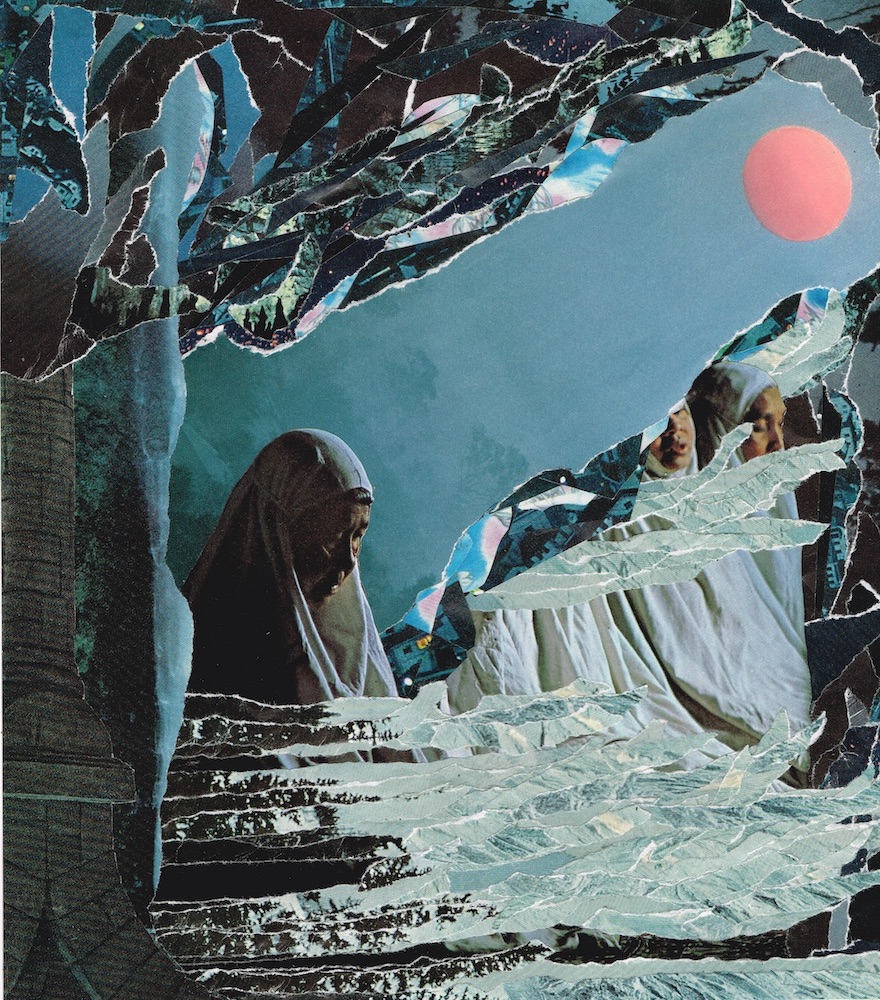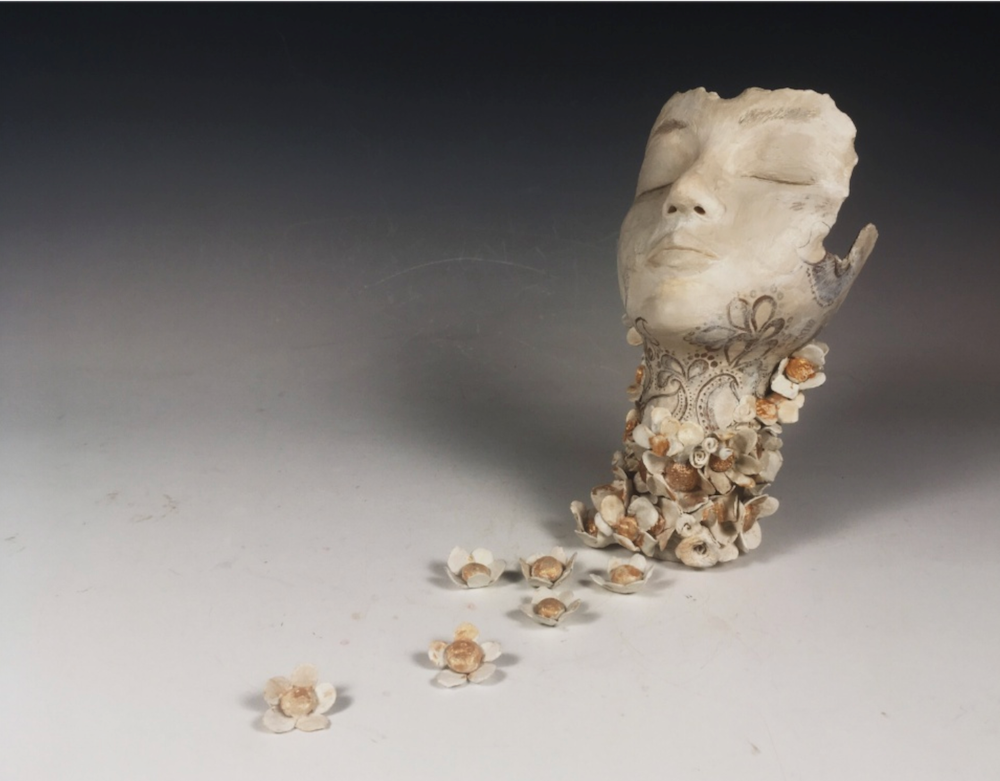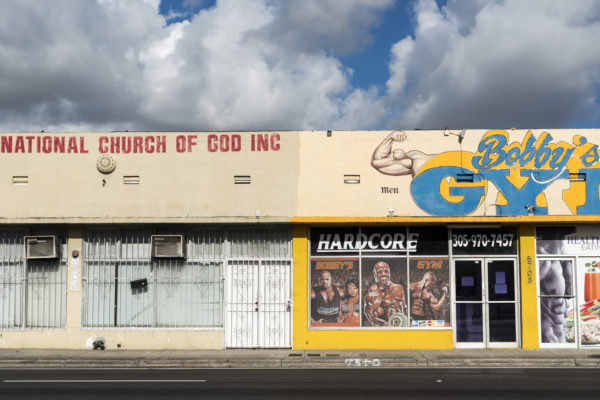(Above: Cover of Katie Giritlian and Esteban Jefferson’s and here, (2018), fabric, thread, and paper, 8 1/2 x 5 1/2 inches.)
On Monday, October 22, I spoke with artists Katie Giritlian and Esteban Jefferson about their collaboration and here,. The work will be released as the second issue of prompt:, a new publication from Mira Dayal and Nicole Kaack that asks two artists who have never worked together to produce a publication presented as a draft for further research. and here, takes the form of an email thread between Giritlian and Jefferson dating from July 2 to August 23, 2018. It launches today, Friday, October 26, at the CUE Art Foundation in Manhattan.
Our discussion centered on Giritlian and Jefferson’s inquiries into recorded family histories, and how the act of sharing their discoveries through the medium of an email thread informed their investigations and artistic practices. The thread—printed and bound for prompt:, and filled with incongruous lines, multicolored fonts, cut-off and overlapping images and lettering—manifests simultaneously as a publication, an artwork, and an archive. Over the course of nine weeks, the two shared anecdotes of family outings to East New York, grandparents assimilating in America after immigrating from Turkey as an Armenian (Giritlian) and Panama (Jefferson), a video, a screenshot of an Instagram post, old family photographs, and photographs of people they do not know but want to know.
Taylor Fisch: How did you guys reach the decision to explore family archives in and here,?
Esteban Jefferson: We had not planned on exploring family archives—that was something that came up organically when we first started talking to each other.
Katie Giritlian: We knew that Mira and Nicole brought us together because of our shared interest in working with image and text, specifically, as they so seamlessly put it, in various forms of the “diaristic.” While Esteban had explored his family archives in prior work, research in my own family archive is new for me. It was serendipitous that during the beginning of our exchange I received a text from my dad informing me that my family was going to receive his mother’s journals and albums, material I didn’t even know existed. The anticipation and eagerness to engage with the material bleed through and here, but it wasn’t until after we had already wrapped up the content of the publication that I was able to go home and see the archives for the first time.
TF: How did you decide to begin to exchange family archival material and anecdotes via email?
KG: In our first meeting we began discussing our family histories and how much material, mainly photographs, we both had, although for me most of these photographs weren’t of or from my family. Knowing that we would be working with image and text, we played around with the idea of sharing an image, or several, and explanations of images per email. That led me to think about the gesture of “and here.” In my work, I think a lot about gestures of sharing.
EJ: We never ended up setting a parameter about whether the images we shared would be about our families. We also didn’t know that the email thread would end up being the form the publication would take. Katie and I said, “let’s write some emails,” to help us generate content. Then much later in the process it became, “let’s just show the emails!” and now that’s the book. We were sending images and writing that we knew would end up being published in some format—they weren’t just random notes—but at the start of it we never thought we would publish it as an email thread.
KG: We printed out the first five emails for our first meeting with Mira and Nicole to show them what we had been working on. When I tried to print the emails, I realized that printing emails was so hard! The layers, the palimpsests, everything! The materiality of it was really unexpected and interesting. We all got excited about the idea of the email as the final product.
Spread from Katie Giritlian and Esteban Jefferson’s and here, (2018), fabric, thread, and paper, 8 1/2 x 11 inches.
TF: Is and here, the entire email correspondence? It feels that we are getting a snapshot of a longer conversation?
KG: There is nothing before my first email to Esteban or after Esteban’s last email to me that is not printed in and here,. There are some text messages and our conversations when we first met for drinks and then again at a coffee shop, but nothing in a thread. Other than copy editing, there are no edits to the actual content—all the typeset errors are how the thread saved as a PDF. When we were putting the book together—post-completion of the content—we printed each email out and realized that as you go forward in the chains each thread is going to get longer and longer because each chain has one more email. We asked ourselves what the balance was of holding this rhythm together without being alienating to the reader. We made the choice to only have the bleed of the prior email up to the right page until you get to the last email where you see everything—the green, the teal, the purple. Since we allowed for at least one page of prior emails, the reader still gets to see that rhythm throughout.

EJ: We decided at some point that it would be more interesting if it wasn’t as finely tuned, to go in to each response knowing that we would be writing something that would probably be seen. Even towards the end we contemplated how best to wrap the discussion up. The open ended platform designed by Mira and Nicole allowed for our conclusions to be less finite, but we did need to come to some resolution. So it ends with both Katie and I having decided to work on these new projects related to our family history, with me in the form of video content and Katie via captions, and now it is time for us to go back to the studio and generate this work.
TF: When you first noticed the incompatible nature of transferring the digital email thread to the printed page did you see “the glitches”—the awkward cropping, fragmented images, links you can’t click on, the distorted cool face emoji—as metaphorically related to the inevitable gaps and inconsistencies in recorded history? It seems to speak to the nature of archives, whether a page of a letter or a corner of a photograph is missing, you have to reconcile those missing pieces.
EJ: Yeah, when we were thinking about how to print out the emails and show everything, it just felt honest to me. I think there is a metaphor there to our discussion about family history and how family history is in general. There is a lot of information that you grow up thinking is true, and then find out isn’t. I think most of us have something like that in our family. There is some kind of a weird Caribbean mythologizing happening. I always grew up hearing that the Panamanian side of my family was part Indian. Then we did a DNA test a few years back and learned that it is just not true. The reason for this family fiction and why fiction develops is interesting to me. I know that my family comes from places where there is a lot of colorism. Creating a narrative that you are more multiethnic than you are can be a counterbalance to that kind of colorism they were facing.
KG: When I was growing up I would be told contradicting anecdotes. There were a lot of fictions used. I don’t know what the purpose of those fictions were. Was it for survival or for my own safety? I don’t know. As I got older I began to notice my own compulsiveness towards details as a potential counter to that. That being said, I also so love and value the space of fiction as a way of working with archives.

TF: and here, concludes with a short text that beautifully ties the threads together. You poignantly ask, “Is collecting records contingent on the desire to relay?” I am intrigued by that question, and wonder if working within the confines of art enhances and gives value to your desire to collect family records?
EJ: I suppose I’m assembling some kind of archive of family history to share with future generations of my family, but I think the primary reason for this research is that it helps me contextualize myself. It’s really for me more than anything. I think one of the most interesting things about being an artist is that you don’t have to make a delineation between what is material and what is just interesting to you. Hopefully, it is also interesting to other people. I don’t want to think of family as material, but then it also is. It is probably beneficial, at least for me in my studio, to not think about the research I am doing on my family as something that will end up as a piece. The compelling things are the things that I feel like have a tie to something outside of just my life or the things I am interested in making into art specifically for a gallery setting. For example, I think immigrant stories are really interesting.
KG: That speaks to your last email to me in and here, where you mention wanting to shoot more video footage of your family, but you write, “Maybe it would be art, maybe not” (p. 41). But to answer your question, when I collect archival material there is always the hope that I will get to share it and its anecdote with at least one other than myself. Another part of my practice is facilitating workshops, such as listening sessions, and I am really interested in the context of group spaces. Even if individuals are not coming away with physical objects, we create collective experiences in these temporal spaces by talking through and sharing our histories.

TF: I want to address Esteban’s mention of his interest in immigrant stories. In the publication, you both speak to your family’s history of “American assimilation.” Do you think the fact that each of you are American, but have parents that immigrated from other countries, impacts your desire to dig more into your family history—as a way to better understand the part of you that’s not or doesn’t feel American?
EJ: Totally.
KG: Yeah, this goes back to the idea of fiction, but also the narrative around how assimilation works. It is so American to assume no history. I always think about the cowboy as an unsentimental American ideal. When I contemplate the fiction of assimilation and the fictionalizing that happens with Americanizing it heightens the urgency I feel to dig deeper into these histories.
EJ: I think history is important to know and I want to know my family’s history. But on the topic of fictionalizing, there is a big part of me that knows I will never really know what is true and what is fiction, especially on my dad’s side of the family where there are no records. But the lack of records makes me more interested in trying to learn about that history and trying to pull those last bits of records I can find.
KG: Being tied to a diasporic community, and Armenians are identified as such, makes the personal seem more connected to a larger network, which is why I am excited to continue the exploration outlined in and here,. I am not yet sure what it means to use family as material so that is why I think I am excited to collect captions across the board, and not just of my own family history but as a way to figure out some kind of research method. The photograph and the caption are in tandem. I love the caption because it stretches out the photograph as an event in time and in turn you get information out of it, whether it exposes a voice or a desire.

TF: The connection both of you felt with people imaged in photographs, whether you knew them or not, is another trope in and here,. How can an individual connect to the archival material of others? Was either of you able to understand your own histories better through the material shared to you in the thread?
KG: A little while ago I participated in a publishing workshop led by Press Press, a small publishing house based in Baltimore. The workshop was centered on the word “sanctuary,” and someone said that to them “sanctuary” is blurry or that they feel “sanctuary” when things feel blurry. That stuck with me—the idea that diasporic communities can find familiarity and the potential to create a bond with the content in blurry photographs. That is something I now think about a lot, the potential in the defects of older technology. I know that is obviously so nostalgic, but it’s more about working with that nostalgia as material. And this potential in finding familiarity in the blurred feels also specific to Armenian diaspora, as there is both a search for a belonging while also acknowledging that, in certain circumstances, they have been able to benefit from whiteness.
EJ: Even mundane stories from a different era feel interesting to me sometimes. But outside of all of that, I think both of our families actually had really fascinating experiences. I was really excited to see the kind of images that Katie’s family has and comparing that to the kind of images my family has because we come from really different cultures. I am always interested in seeing other people’s family photos, family histories, and hearing about old generations and contextualizing my family’s stuff via other people’s.
KG: I remember I felt so moved when I watched the video Esteban sent to me. What had moved me were these gestures. First the camera is far away and I can only hear the dialogue of Esteban and his family sharing photos. It is not until the end where you see Esteban with the camera in his hand and the physical gestures of sharing images. You realize photographs are being talked about, but you are unable to see them. I was just so moved by this very long introduction that was all “and here’s”: “Here’s me!” “Here’s you!”
EJ: I liked the screenshots! And I liked seeing my Dad’s cousin making fun of him in that video. But now that I think about it, if you read and here, you don’t actually get to see that video. It is not present.
Spread from Katie Giritlian and Esteban Jefferson’s and here, (2018), fabric, thread, and paper, 8 1/2 x 11 inches.
TF: Katie plays a role in making that video more present when she sends you back stills with captions from her favorite moments. Katie, were you consciously sculpting your own archive from Esteban’s footage?
KG: I did not notice that until right now, but that totally feels valid! I also felt that we had built a level of trust at that point. After Esteban sent that link and I watched the video, I had such a positive reaction to it. I really wanted to include it in some capacity in the archive that is this book. I had the urgency to include part of it and I think we were at this point where I could do this without asking, but it felt like a risk, if that makes sense. I know he had already sent me the video in the thread, so its mentioning was already there, but to include a piece from the video that I had done and place it even more into the archive than he had previously intended was a risk, I thought. We had established that this would be a shared archive, but I wasn’t sure that it would be opening another thread that surpassed the boundaries of our project.
EJ: I’m very open with my family history, but I do think that we did have a level of trust that made it okay to reference each other’s families in the collaborative work we both knew we were making.
TF: This can be seen as a similar gesture to when Katie sent you a photo her dad sent her of an image in her grandmother’s photo album, where she writes the caption, “Me trying to line my phone’s shadow with that of my dad’s” (p. 26). Katie, do you think that connection is also there?
KG: Perhaps…I need to think more about it. But my immediate response is yes, and maybe the connection between the two is the desire to archive various moments of passing down and highlighting the different gestures for passing down. These screenshots and photographs are not archives in an efficient sense, but there is an interest in archiving these modes of passing down.

TF: In addition to performing gestures of sharing, you both make note of the various ways information is passed down. Esteban presents the wild discrepancy between his paternal grandparents’ 4-5 generations of oral immigration history versus the 1,000 year written immigration history on his maternal side. In a similar vein, Katie, you always make a clear point of dictating how you learned about various pieces of information—whether it is a text from your dad or a transcribed phone conversation. Is the way in which information is shared just as significant as what is being shared?
EJ: My mom’s family has a book that has our 1,000 years of history written down, and I am way less interested in looking at that. I am really into photos—that’s what I want to see. But I want to know who is in the photos and understand the story behind the photos. For me, the images are the most interesting thing, and just finding the information, the same information that Katie finds via captions, but through images.
KG: To me, the gesture of sharing is not more, but as important as what is being shared. Similar to my interest in the caption and the various modes of messaging, I get excited to learn about history. You learn a lot about history by learning not just the message but the mode of passing down and hearing the different voices presented through those mediums.
All images courtesy the artists and prompt:.
